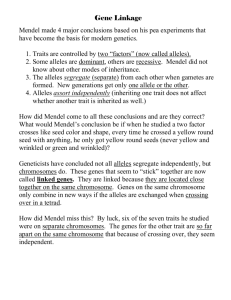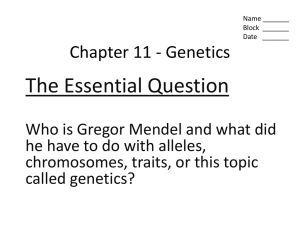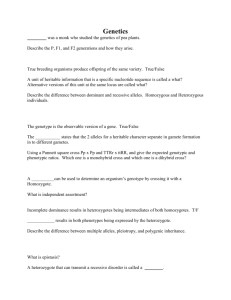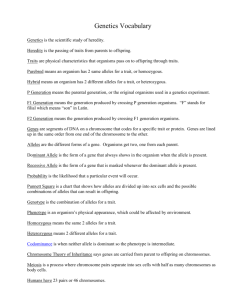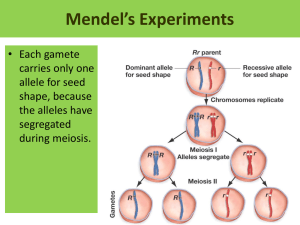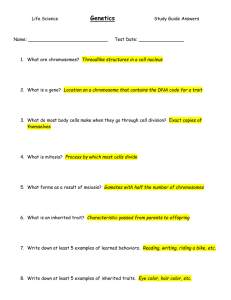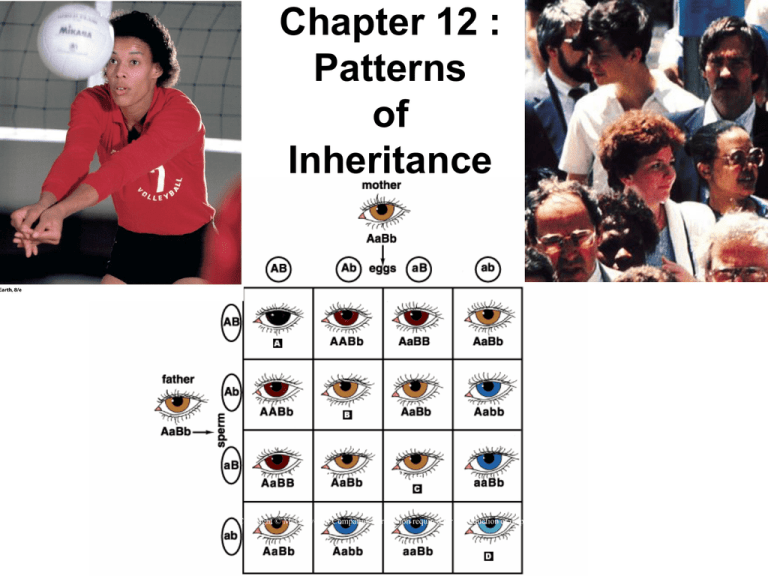
Chapter 12 :
Patterns
of
Inheritance
Copyright © McGraw-Hill Companies Permission required for reproduction or display
Chapter 12 Outline
•
•
•
•
Physical Basis of Inheritance
Mendel
Single Traits
Multiple Traits on Different and same
Chromosomes
• Sex Determination and Sex-Linked Inheritance
• Non-Mendelian genetics
• Human Genetic Disorders (defective genes or
chromosomic number).
Inheritance
•
Inheritance is the process by which the
characteristics of individuals are _______
___________
• _________ encode these characteristics
• A gene is a ___________ that encodes
•
information for the form of a particular
characteristic
The location of a gene on a chromosome
is called its ___________
Alleles
Homologous chromosomes carry the
_________________ for the same
characteristics (at the same loci)
Genes for the same trait may show
alternate versions, called ________
Each cell carries ___alleles per
characteristic, one on each of the two
homologous chromosomes
– Same alleles __________ individual;
– Different alleles ___________
pair of
homologous
chromosomes
Color
Height
shape
Gregor Mendel
•
•
•
Augustinian monk in late
_____ in the now Czech
Republic)
Studied botany and
mathematics at the
university level
Experimentation with
__________ inheritance
took place in the
monastery garden
Advantages of Garden Pea :
• Large number of ___________ varieties
(homozygous for a trait, always producing
the same physical form)
• Many ___________ previously produced.
– Expect ___________ of traits.
• Small and _______ to grow.
– Short generation time.
• Sexual Organs enclosed in flower.
– _____-fertilization
– ________ fertilization
Mendel’s Experimental Design
• He studied characteristics that have ______ forms
(like purple versus white)
• He only studied ________ (characteristic) at a time
• Applies ________ to explain his results
• Allowed pea plants to ___________ for several
generations.
– Assured constant traits.
• Performed _________ between varieties exhibiting
alternative character forms.
• Permitted _____ offspring to ________ for several
generations.
Mendel’s Results
• F1 Generation (First
Filial)
• Offspring of white X
purple flower:
– flower color resembling
one parent (no blending
inheritance).
– All flowers exhibited
purple flowers
(dominant trait) and
none exhibited white
flowers (recessive trait).
pollen
Parental
generation (P)
pollen
cross-fertilize
true-breeding,
purple-flowered
plant
true-breeding,
white-flowered
plant
First-generation
offspring (F1)
all purple-flowered
plants
Copyright © 2005 Pearson Prentice Hall, Inc.
Mendel’s Results
• F2 Generation (Second
Filial)
– F1 X F1 plants (purple)
F2 mostly purple but some
white (recessive)!
– Dominant : Recessive
ratio among F2 plants was
always close to 3:1.
• Discovered ¼ were always
true breeding recessives.
• Disguised 1:2:1 ratio
Firstgeneration
offspring (F1)
self-fertilize
Secondgeneration
offspring (F2)
3/4 purple
1/4 white
Copyright © 2005 Pearson Prentice Hall, Inc.
• Explanation: Law of Segregation
• The two alleles for a characteristic separate during gamete
formation (meiosis)
– Homologous chromosomes separate in meiosis anaphase I
– Each gamete receives one of each pair of homologous chromosomes
and thus one of the two alleles per characteristic. Homozygous produces all
gametes with same alleles
meiosis
A
A
homozygous parent
A
A
gametes
Heterozygous produces gametes with different alleles
A
a
heterozygous parent
A
a
gametes
purple parent
P
PP
P
all P sperm and eggs
white parent
pp
p
p
all p sperm and eggs
Copyright © 2005 Pearson Prentice Hall, Inc.
F1
offspring
sperm
eggs
P
p
Pp
P
Pp
or
p
Gametes from F1 can be…
gametes from
F1 plants
eggs
sperm
F2
offspring
P
P
PP
P
p
Pp
p
P
Pp
p
p
pp
Mendel’s Model of Heredity
• Factors: Parents transmit discrete
physiological trait information (______ ) to
offspring.
• 2: Each individual receives _________ that
may code for same, or alternative, character
traits.
• Not identical: Not all copies of a factor are
identical.
– Alleles
• ___________ - Same alleles.
• ___________ - Different alleles.
Mendel’s Model of Heredity
• The two alleles do not influence each other in
any way.
• Presence of a particular allele does not ensure
its encoded trait will be expressed in an
individual carrying that allele.
– ___________ - Totality of alleles.
– ___________ - Physical appearance.
Interpretation of Mendel’s Results
• Notational Convention
– __ - Dominant allele (___________ )
– __ - Recessive allele (___________ )
• PP - Homozygous ___________ (purple)
• Pp – ___________ but is purple
• pp - Homozygous ___________ (white)
Interpretation of Mendel’s Results
• F1 Generation
– PP x pp (parental
generation) yielded all
Pp offspring.
• F2 Generation
– Pp x Pp yielded:
(1:2:1) ratio
• 1 PP
• 2 Pp
• 1 pp
• Punnett Squares
Punnett squares
Pp
self-fertilize
1
2
P
eggs
1
2
p
1 P
2
sperm
1
4
1
4
PP
Pp
1
p
2
1
4
sperm
1
4
pP
offspring
genotypes
eggs
1 P
2
1
2
P
1
4
PP
1
P
2
1
2
p
1
4
Pp
genotypic
ratio
(1:2:1)
P
1
2 P
1
2
P
1
4
pP
1
2
p
1
4
pp
phenotypic
ratio
(3:1)
1
PP
4
2
4 Pp
1
2
pp
1
4 pp
3
4 purple
1
white
4
sperm
eggs
offspring
genotypes
1
2
P
1
2
P
1
4
PP
1
2
P
1
2
p
1
4
Pp
genotypic
ratio
(1:2:1)
1
4
2
4
1
2
1
2
P
1
2
P
1
4
pP
P
1
2
p
1
4
pp
1
4
phenotypic
ratio
(3:1)
PP
3
4
purple
1
4
white
Pp
pp
Mendelian Inheritance
• Mendel’s First Law of Heredity: __________
From ___________ crosses (___________
_______________ ):
– Alternative alleles of a character segregate from
each other in heterozygous individuals and
remain distinct (the _____________________
_________________________________
Testcross
• If you cross a plant with a_______ phenotype
but an ________ _______ (PP or Pp) with a
________________________(pp), the two
possible genotypes will yield different results.
pollen
PP or Pp
sperm unknown
pp
all eggs p
if PP
if Pp
p
egg
all
sperm P
p
all Pp
sperm
1
P
2
1 Pp
2
1
p
2
1
2 pp
egg
Mendelian Inheritance
• Mendel’s Second Law of Heredity:
___________ ___________
– From _______ _______ (two characters varied
in cross): i.e. color and texture
– Genes that are located on ___________
___________ assort independently of one
another.
Second Law:
of Independent
Assortment
Seed
shape
smooth
wrinkled
yellow
green
inflated
constricted
green
yellow
purple
white
at leaf
junctions
at tips of
branches
tall
(1.8 to
2 meters)
dwarf
(0.2 to 0.4
meters)
Seed
color
Pod
shape
Pod
color
Flower
color
Flower
location
Plant
size
Dihybrid cross:
Considering Shape and
Color:
F2
SsYy
self-fertilize
eggs
Shape: either Smooth (S) or wrinkled (s)
Color: either Yellow (Y) or green (y)
1
4
1
4
sperm
Cross: Smooth (S) and Yellow (Y) x
wrinkled (s) and green (y)
1
4
1
4
SSYY
x
ssyy
1
4
SY
Sy
1
4
SY
1
4
1
4
sY
sy
1
16
SSYY
1
16
SSYy
1
16
SsYY
1
16
SsYy
1
16
SSyY
1
16
SSyy
1
16
SsyY
1
16
Ssyy
1
16
sSYY
1
16
sSYy
1
16
ssYY
1
16
ssYy
1
16
sSyY
1
16
sSyy
1
16
ssyY
1
16
ssyy
sY
sy
3
4
smooth x
3
4
yellow
phenotypic ratio
(9:3:3:1)
9
= 16 smooth yellow
3
4
smooth x
1
4
green
=
3
16
smooth green
1
4
wrinkled x
3
4
yellow
=
3
16
wrinkled yellow
1
4
wrinkled x
1
4
green
=
1
16
wrinkled green
seed shape
F1= SsYy
Smooth and Yellow
Sy
seed color
Copyright © 2005 Pearson Prentice Hall, Inc.
S
pairs of alleles on homologous
chromosomes in diploid cells
s
Y
y
S
Y
s
y
chromosomes
replicate
replicated homologues
pair during metaphase
of meiosis I,
S
orienting like this
or like this
s
y
Y
meiosis I
S
Y
s
y
S
y
s
Y
S
Y
s
y
S
y
s
Y
meiosis II
S
S
Y
s
Y
SY
y
y
s
S
S
s
y
y
sy
Sy
independent assortment produces four equally
likely allele combinations during meiosis
Copyright © 2005 Pearson Prentice Hall, Inc.
s
Y
Y
sY
Genes on the Same Chromosome
•
•
If 2 genes are on the _____ _________
, they are usually ____ , unless there is a
lot of distance between them. If there is
enough distance, ___________ may
occur.
Example of genetic linkage
– Flower color and pollen shape are on the
same chromosome in peas
– Gene assignments
•
•
Let P = purple flowers and p = red flowers
Let L = long pollen shape and l = round shape
Recombination
•
•
•
Genes on the same chromosome do not
always sort together
Crossing over in Prophase I of meiosis
creates ___________
Crossing over involves the exchange of
DNA between chromatids of paired
homologous chromosomes in _________
Recombination
•
Example of crossing over for flower color and
pollen shape with parent PpLl
–
–
Assume P is linked with L and p is linked with l
Crossover between chromatids of different homologous
replicated chromosomes yields some pL and Pl
gametes
P
L
P
L
P
L
P
L
p
L
p
L
p
p
l
l
P
p
l
l
P
p
l
l
Human Chromosomes
• Human somatic cells have normally have
____ pairs of chromosomes (____ total).
– ____ pairs of ___________
– 1 pair of s____ ___________
• XX = ___________
• XY = ___________
female parent
Sex Determination in
mammals:
X1
X2
XX= female
eggs
XY= male
X1
X1
male parent
Y
Xm
X2
Xm
Xm
sperm
Xm
X2
female offspring
X1
Y
X2
Y
male offspring
Y
X chromosome is
much larger than
the Y and carries
over 1000 genes
Y chromosome is
smaller and carries
only 78 genes
Human Chromosomes
• Mosaics:
• One X chromosome in
females is _________ to
heterochromatin early in
embryonic development
(phenotypic __________
, e.g. calico cat)
– Visible as a darkly
staining ___________
attached to the nuclear
membrane.
Sex-linkage
• A trait determined by a gene on the sex
chromosome is said to be __________ .
• First discovered in Drosophila in early
1900s
• Eye color genes carried by the X
chromosome
– R = red eyes (___________ )
– r = white eyes (___________ )
female parent
Eye color is linked to the
X chromosome in flies
r
R
XRXr
XR Xr
R
r
eggs
XR
R
Xr
R
R
r
R
all the F2
females
have red eyes
male parent
XRY
XR
sperm
R
XR Y
Y
XR XR
female offspring
R
Xr XR
half the F2
males
have red eyes,
half have white
eyes
r
XRY
male offspring
Xr Y
How Sex-Linkage Affects Inheritance
•
Sex-linked (specifically X-linked) recessive
alleles displayed their phenotype more often
in ___________
– Males showed recessive white-eyed phenotype
more often than females in an
XRXr x XrY cross
Males do not have a second X-linked gene (as do
females) which can ______ a recessive gene if
dominant
Incomplete Dominance
• Heterozygotes have
RR
RR
RR
RR
F1:
____________________
F2:
– Two copies of the C1 allele
curly hair
– Two copies of the C2 allele
straight hair
– Heterozygotes (C1C2
genotype) wavy hair
1
2
1
2
1
2
R
1
4
RR
1
4
RR’
1
4
RR
1
4
R’R
eggs
1
2
R
sperm
• (i.e. : snapdragon color;
human hair texture)
R
Incomplete Dominance
• If two wavy-haired
people marry, their
children could have
any of the three hair
types: curly (C1C1),
wavy (C1C2), or
straight (C2C2)
Multiple Alleles
• Having __________________________ for a given
characteristic
• Thousands of alleles for eye color in fruit flies, producing white,
yellow, orange, pink, brown, or red eyes
• Human blood group genes producing blood types A,
B, AB, and O
– Three alleles in this system: A, B, and O: red blood
cells with _________________ added in the membrane:
– B = IB adds ___________
– A = IA adds ___________
– O = i adds ___________
– AB = IAB ___________
Codominance
•
•
___________–
Heterozygous
express both
phenotypes.
Example: Human
blood group alleles
–
Alleles ________ are
codominant
–
Type _________ is
seen where individual
has the genotype AB
__________
Inheritance
•
Phenotypes result
from interaction of
more than two genes
at multiple loci
Phenotypes show a
_________
___________ , rather
than discrete.
–
Examples include
________ __________
__________, and body
build, and grain color in
R1R1R2R2
eggs
R1R2
R1R2
sperm
•
R1R1R2R2
R1R2
R1R2
R1R1R2R2
R1R2
R1R1R2R2
R1R1R2R2 R1R1R2R2
R1R1R2R2
R1R1R2R2
R1R2
R1R1R2R2
R1R1R2R2
R1R1R2R2
R1R2
R1R1R2R2
R1R1R2R2
R1R1R2R2
R1R1R2R2
R1R2
R1R1R1R2
R1R1R2R2
R1R1R2R2
Polygenic Inheritance
•
Human skin color is
controlled by at least 3
genes, each with pairs
of incompletely
dominant alleles
______________________
•
Degree of allele expression may depend on the
environment.
–
i.e. temperature and color
•
–
Himalayan rabbit with black fur genotype will express it only
in colder areas of the body
Identical twin studies in humans reveal different IQ
scores between twins
Pleiotropy
•
Some alleles of a characteristic may create
___________ ___________
(___________ )
– Mendel’s rules specify only one phenotype
possible for any allele
•
Example: The SRY gene in male humans
– SRY gene stimulates development of gonads
into testes, which in turn stimulate
development of the prostate, seminal vesicles,
penis, and scrotum
A pedigree for a dominant trait
Human Genetic
Disorders
• Records of gene
expression over several
generations of a family can
be diagrammed
• Careful analysis of this
diagram (a __________ )
can reveal inheritance
pattern of a trait
• Family pedigrees
I
II
III
A pedigree for a recessive trait
I
II
?
?
?
?
III
?
IV
?
?
How to read pedigrees
I, II, III = generations
= male
= female
= parents
= offspring
or
= shows trait
or
= does not show trait
or
= known carrier (heterozygote) for
recessive trait
? or ?
Pedigree Analysis
•
Pedigree analysis is often combined with
molecular genetics technology to elucidate
gene action and expression
Human Gene Disorders
Human Genetic Disorders
• ___________ of a detrimental allele.
– Most disorders are produced by ___________ coding
for ___________ proteins. Examples:
• ___________
• ___________
– ____, because affected individuals often die at a
relatively young age, or cannot reproduce.
– Heterozygous individuals are _______ of a recessive
genetic trait (but otherwise have a normal phenotype)
– Homozygous individuals are more common when
individuals are related
Albinism
• _______ is the dark pigment that colors skin cells, produced
by the enzyme tyrosinase
• An allele known as ____(for tyrosinase) encodes a _______
tyrosinase protein in skin cells, producing no melanin.
Humans and other mammals who are homozygous for TYR
have no skin, fur, or eye coloring (skin and hair appear white,
eyes are pink)
Sickle-Cell Anemia
•
Hemoglobin is an oxygen-transporting protein
found in red blood cells. A mutant gene causes
red blood cells to take on a sickle
(crescent) shape and easily break
– Blood _____ can form, leading to oxygen
starvation of tissues and paralysis
– Condition is known as sickle-cell anemia
Sickle-Cell Anemia
•
About 8% of the African population is
heterozygous for sickle-cell anemia
– Heterozygous individuals have some __
___________ _________
Dominant Genetic Disorders
•
Dominant disease alleles disrupt normal
cell function in a variety of ways
– Produce an _____________ that interferes
with the function of the normal one
– Encode _________proteins
– Encode a protein that is overactive or active at
___________ times and places
•
Transmitted from homozygous dominant,
_________ , or arise from eggs or sperm
mutations from healthy parents’ DNA
Dominant Genetic Disorders
•
Huntington’s
Disease
– _______ lethal
– _______ onset
of symptoms
– Trinucleotide
repeat-based
disorder
Sex-Linked Genetic Disorders
•
•
Several defective alleles for characteristics
encoded on the X chromosome are known
Sex-linked disorders appear more
frequently in __________and often skip
generations
Sex-linked genetic disorders
– Red-green color
blindness
Sex-Linked Genetic Disorders
• Hemophilia (deficiency in ________
___________ protein)
– Hemophilia gene in Queen Victoria of England
was passed among the royal families of
Europe
Hemophilia
Sex linked
Deficiency in blood clotting
Edward
Duke of Kent
Albert
Prince
of SaxeCoburg-Gotha
Edward VII
King of
England
unaffected male
hemophiliac male
unaffected female
carrier female
Victoria
Princess of
Saxe-Coburg
Victoria
Queen
of England
Alexandra
of Denmark
Leopold
Duke
of Albany
Helen
Louis IV
Princess of
Grand Duke of
Waldeck-Pyrmont Hesse-Darmstadt
Alice
Princess
of Hesse
several
unaffected
chidren
Beatrice
Henry
Prince of
Battenburg
present British
royal family
(unaffected)
Victoria Elizabeth Alexandra
Mary
Tsarina
carrier
daughter
and
hemophiliac
grandson
Nicholas II Frederick Ernest Mary Irene
Victoria
of Russia
?
?
?
?
Olga
Tatiana
Maria
Anastasia
Alexander Alfonso
Albert
XII
Victoria Leopold Maurice
Queen
of Spain
?
Alexis
Tsarevitch
Alfonso
Crown
Prince
Copyright © 2004 Pearson Prentice Hall, Inc.
Juan
Beatrice
?
died Marie Jaime Gonzalo
in
infancy
Abnormal Chromosome Number
•
•
Failure of chromosomes to separate
correctly during meiosis I or II is called
___________ _____________
Non-disjunction of ________ can occur
during meiosis in the father or mother
– Frequency of non-disjunction increases with
the age of the parents
– Fertilized egg has either one or three copies
of an autosomal chromosome
Abnormal Autosome Number
• ___________ caused by
___________
• 1 in 1700 for mothers < 20
– 1 in 1400 for mothers >20<30
– 1 in 750 for mothers >30<35
– 1 in 16 for mothers >45
• Nearly all other autosomal
trisomic conditions are ____
during development
Abnormal Autosome Number
• Down Syndrome
– Characterized by
distinctively shaped
eyelids, among other
physical features
Abnormal Sex Chromosome Number
• Produced by nondisjunction of sex
chromosomes
• X Chromosome
– ____ - ___________
syndrome
– ____ - ___________
Syndrome
– ____ – ___________
• Y Chromosome
Klinefelter 47 (XXY)
Turner
Turner : 45, X (or XO)
XYY
XXX

